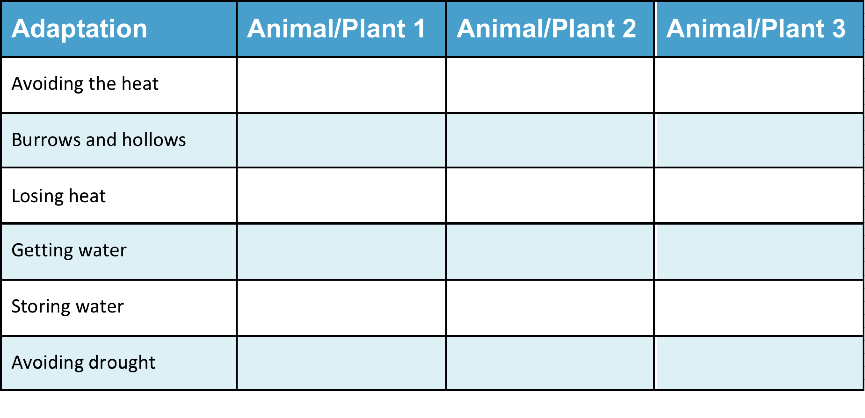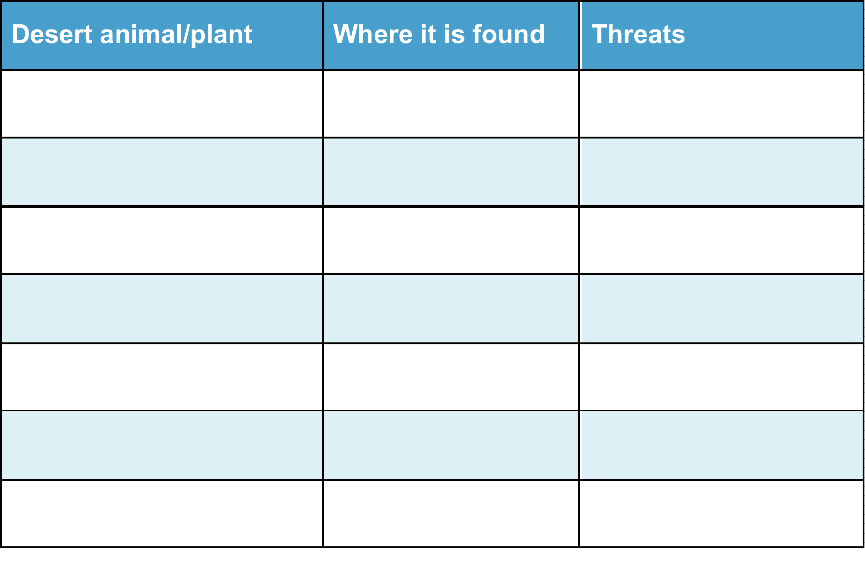Information for Teachers
Curriculum links
Australian Science Standards
BS (ACSSU43) Structural features and adaptations of living things assist their survival
BS (ACSSU43) Adaptations of living things for particular environments
SS01.7 Actions for a more sustainable future reflect values of care, respect and responsibility, and require us to explore and understand environments
New Zealand Science Achievement Objectives
PEB: The external and internal processes that shape and change the surface features of the land
LW: The importance of variation within a changing environment
Helpful websites
You may want to direct your students to some or all of these websites to help with their investigations.
http://www.softschools.com/facts/biomes/desert_biome_facts/167/
https://www.worldwildlife.org/habitats/deserts
http://kids.nceas.ucsb.edu/biomes/desert.html
https://listovative.com/top-9-plants-commonly-found-deserts/
https://www.desertusa.com/animals.html
https://www.desertusa.com/survive.html
https://www.desertmuseum.org/books/nhsd_adaptations_birds.php
http://mentalfloss.com/article/57204/20-amazing-animal-adaptations-living-desert
http://listverse.com/2016/07/07/10-desert-animals-with-brilliant-survival-adaptations/
How to search the internet
1 Keep your request short
Fewer words will give a more accurate search.
2 Choose exactly what you want
For example: Arctic Circle Climate
3 Use quotes
Double quotes around a set of words tell the search engine to consider those exact words in that exact order without any change. For example: “Arctic Circle Climate”
4 Use the plus sign (+)
If you add a plus sign (+) between words, the internet will search for all the words. For example: migrate+birds+whales+mammal
5 Use the minus sign (–) to say what you don’t want
Use a minus sign (–) to show words you do not want to appear in your results. For example: if you search for burrowing animals and do not want mammals in your search, –mammals will exclude mammals. Note that you need to put a space before the minus sign for the word to be excluded.
6 Be very clear about what you don’t want
Part 1
Ask questions and make predictions
After reading Deserts, you may have further questions about life in these dry environments.
List your questions
- Compare your list with questions that others have.
- Choose a question you would like to investigate.
- You can work alone, with a partner, or in a small group.
You may want to choose one or more of these questions to investigate
Q1. Make a list of interesting animals or plants that are found in deserts. Compare all the ways each animal or plant has adapted to deal with the conditions in desert environments.
Q2. Investigate the arrival of new plant or animal species into a desert environment, e.g. feral cats moving into deserts. What changes have taken places after the arrival of the new species? Has the balance of the ecosystem been changed or damaged?
Go to Part 2 Plan and investigate →Part 2
Plan and investigate
Do searches in the internet or in books or talk to people who can help to find the information you are looking for.
Your teacher may suggest suitable websites for further information.
Go to Part 3 Record and analyse data →Part 3
Record and analyse data
Find ways of recording your information that will allow you to see any patterns in the data.
Data Chart for comparing desert animals/plants
 Download Chart
Download Chart
Go to Part 4 Evaluate the information →
Part 4
Evaluate the information
1. Look over the information you have gathered and the patterns you have found.
How do animals/plants avoid the heat?
What are the most amazing desert adaptations?
2. Search for other patterns.
Are these adaptations found in most deserts? Why?
What might happen if a new predator or grazing animal is introduced?
3. Makes notes about what you find.
Go to Part 5 Communicate and share ideas →Part 5
Communicate and share ideas
Look over all of the information that you have gathered in your investigation.
What are the most important ideas about your topic?
Make a chart showing the most important ideas.
 Download Chart
Download Chart
← Return to menu
